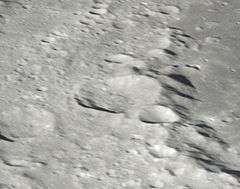Tereshkova (crater)
Tereshkova is a relatively small lunar impact crater on the far side of the Moon. It is located along the western perimeter of the Mare Moscoviense, and to the southeast of the crater Feoktistov.
 Oblique Lunar Orbiter 5 image | |
| Coordinates | 28.4°N 144.3°E |
|---|---|
| Diameter | 31 km |
| Depth | Unknown |
| Colongitude | 216° at sunrise |
| Eponym | Valentina V. Tereshkova |

It is named for cosmonaut Valentina Tereshkova, the first woman in space. Normally craters are named after dead people; Tereshkova was among the first group of living people to have a crater named for them.[1]
The rim of this crater resembles a rounded hexagon in outline. There is a small, cup-shaped crater near the outer edge of the southern rim. The eastern ramparts of this crater merge with the edge of the Mare Moscoviense. The rim edge is worn, but only tiny craterlets pit the surface of the edge and the crater interior.
Satellite craters
By convention these features are identified on lunar maps by placing the letter on the side of the crater midpoint that is closest to Tereshkova.
| Tereshkova | Latitude | Longitude | Diameter |
|---|---|---|---|
| U | 28.7° N | 142.8° E | 23 km |
References
- Andersson, L. E.; Whitaker, E. A. (1982). NASA Catalogue of Lunar Nomenclature. NASA RP-1097. p. 68.CS1 maint: ref=harv (link)
- Blue, Jennifer (July 25, 2007). "Gazetteer of Planetary Nomenclature". USGS. Retrieved 2007-08-05.CS1 maint: ref=harv (link)
- Bussey, B.; Spudis, P. (2004). The Clementine Atlas of the Moon. New York: Cambridge University Press. ISBN 978-0-521-81528-4.CS1 maint: ref=harv (link)
- Cocks, Elijah E.; Cocks, Josiah C. (1995). Who's Who on the Moon: A Biographical Dictionary of Lunar Nomenclature. Tudor Publishers. ISBN 978-0-936389-27-1.CS1 maint: ref=harv (link)
- McDowell, Jonathan (July 15, 2007). "Lunar Nomenclature". Jonathan's Space Report. Retrieved 2007-10-24.CS1 maint: ref=harv (link)
- Menzel, D. H.; Minnaert, M.; Levin, B.; Dollfus, A.; Bell, B. (1971). "Report on Lunar Nomenclature by the Working Group of Commission 17 of the IAU". Space Science Reviews. 12 (2): 136–186. Bibcode:1971SSRv...12..136M. doi:10.1007/BF00171763.CS1 maint: ref=harv (link)
- Moore, Patrick (2001). On the Moon. Sterling Publishing Co. ISBN 978-0-304-35469-6.CS1 maint: ref=harv (link)
- Price, Fred W. (1988). The Moon Observer's Handbook. Cambridge University Press. ISBN 978-0-521-33500-3.CS1 maint: ref=harv (link)
- Rükl, Antonín (1990). Atlas of the Moon. Kalmbach Books. ISBN 978-0-913135-17-4.CS1 maint: ref=harv (link)
- Webb, Rev. T. W. (1962). Celestial Objects for Common Telescopes (6th revised ed.). Dover. ISBN 978-0-486-20917-3.CS1 maint: ref=harv (link)
- Whitaker, Ewen A. (1999). Mapping and Naming the Moon. Cambridge University Press. ISBN 978-0-521-62248-6.CS1 maint: ref=harv (link)
- Wlasuk, Peter T. (2000). Observing the Moon. Springer. ISBN 978-1-85233-193-1.CS1 maint: ref=harv (link)
- "500 Men Have Moon Craters Named for Them". Messenger-Inquirer. Owensboro, Kentucky. Associated Press. August 22, 1970. p. 2 – via Newspapers.com.